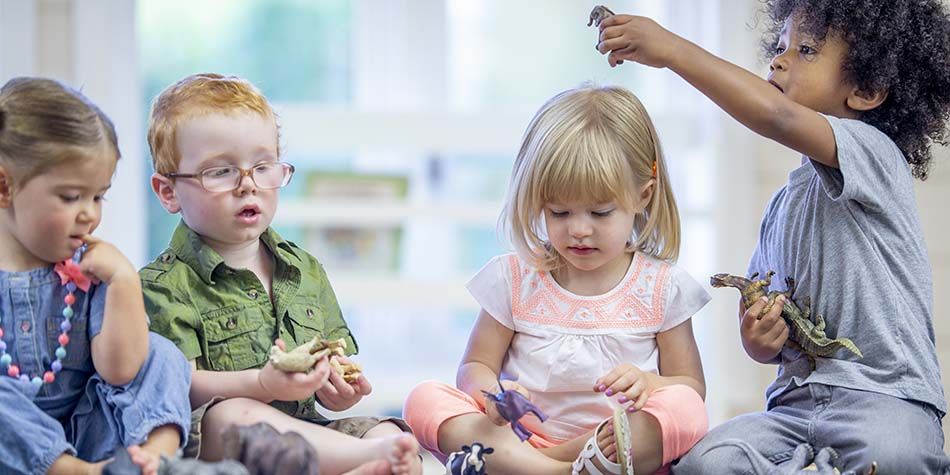
Maybe you’ve noticed that your toddler isn’t playing, speaking, acting or moving like other kids of the same age. Or maybe the difference in your child’s behavior is so slight that you didn’t think it could be connected to their development. Parents are constantly processing information about their children in order to keep them safe and healthy. But you don’t have to go it alone. Pediatricians and pediatric therapists can help you decode your child’s behavior and address any issues — the earlier the better. Here are three signs your toddler’s development may be delayed and when to get help from a qualified medical professional.
Speak with your provider for a referral to EIRMC’s Pediatric Therapies at 208-529-7982.
What are developmental milestones?
Developmental milestones are things that most children (75% or more) can do by a certain age. These milestones fall into several groups:
- Cognitive: Learning, thinking, problem-solving
- Language and communication
- Movement and physical development
- Social and emotional
Developmental milestones in each of these categories become increasingly more complex as children grow. The CDC’s developmental milestones checklists include indicators for infants as young as two months of age and continue through age five. Keep in mind that all children develop differently and a delayed milestone may or may not indicate a problem. That’s why it’s so important to talk to your doctor about any concerns.
Let’s take a look at some important milestones for toddlers and signs that something may be amiss.
Communication milestone: late talking
One of the most exciting milestones for parents is when their child begins to speak, opening up a whole new way to connect. CDC guidelines recommend that by the time children reach 18 months of age, they should be able to:
- Communicate consistently with at least three words other than “mama” or “dada”
- Follow one-step directions, such as, “Please hand me the toy.”
As your child nears two years of age, their communication skills should begin to include:
- Combinations of two or more words, such as “more milk”
- Recognition of:
- Images in a book, such as when you ask, “Where is the dog?”
- At least two body parts
- Gestures more complex than waving and pointing, such as blowing kisses or nodding yes
When to see a specialist for late talking
A child may be considered a “late talker” if they appear to have a good understanding of language and are on track with other developmental milestones but are not communicating with spoken words. You should make an appointment with a speech-language pathologist if your child is:
- 18 to 20 months old and using fewer than 20 words
- 24 months old and using fewer than 100 words and/or not using two-word phrases
Movement and physical development milestone: W-sitting
Parents know that toddlers are the reason babyproofing was invented. By the age of two, most kids are highly mobile and getting into everything. Physical developmental milestones include being able to:
- Use a spoon to feed themselves
- Run
- Kick a ball
- Walk up (not climb) a few stairs, with or without help
While it may be difficult to get your toddler to sit down, once you do, you can look for this developmental clue. It’s called W-sitting. If you’re standing and looking down at your child, their legs will be stretched to the side with knees bent and hips turned in — forming a “W” shape. Lots of kids prefer to sit this way in early childhood.
W-sitting is not a supportive position and can indicate weakness in a child’s core and muscles. It can worsen existing conditions, such as hip dysplasia, and lead to other problems, such as orthopedic and bilateral coordination issues (in which both sides of the body don’t develop equally).
When to see a specialist for W-sitting
If your child is between 24 and 30 months old and is still using W-sitting as their preferred sitting preference, ask your pediatrician for a referral to a pediatric therapist. Look for and report other warning signs, including pain, poor balance or pigeon-toed walking. You can also gently encourage your child to squat or sit with crossed or outstretched legs, or offer fun seating options such as beanbag chairs or small step stools.
Movement and physical development milestone: Toe walking
If your toddler is walking on the balls of the feet, with no contact between their heels and the ground, that’s known as toe walking. It’s very common in children who are learning to walk but can indicate problems in older children. The causes of toe-walking in most cases is unknown, but it can be a sign of an underlying medical condition, including:
- Cerebral palsy
- Muscular dystrophy
- Neurological conditions
- Spinal cord abnormalities
When to see a specialist for toe walking
If your child is nearing three years old and is consistently toe walking, you should seek an evaluation with a pediatric therapist. Even if there is no underlying medical condition, toe walking can cause tightness in your child’s calf muscles and tendons and weakness in the front of the legs. Treatment may include casting or bracing to help stretch the muscles and tendons and allow your child to walk with a normal gait.
You can also try verbal cues, such as "heels down," and work on squatting because it increases range of motion in the ankles. Walking uphill may also be helpful.
If you’re concerned that your toddler isn’t meeting one or more developmental milestones, don’t hesitate to ask your pediatrician for a referral to EIRMC's Pediatric Therapies.
$webqFacilityNumber
Need a Physician?